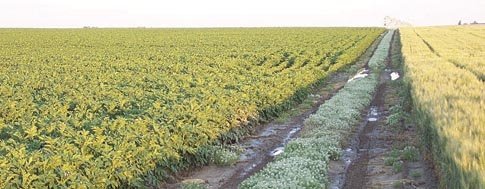
Biodiversity can help with a host of environment-related issues, but if you plant the right species, it can also provide food and shelter for beneficial insects.
When approaching the concept of biodiversity, defined as the diversity of plants and animals in a particular habitat, Gwendolyn Ellen wants growers to think of their farm as an ecological landscape or a “farmscape.” Ellen, who is outreach educator for Oregon State University’s Integrated Plant Protection Center, suggests growers take a 360-degree view of their farm, looking for areas that are already biologically diverse and areas that can be enhanced.
A variety of plants encourage habitat by diverse insect and animal species, including native trees, cover crops, perennial shrubs, weedy patches, and insectary strips, borders, or blocks.
“You probably have landscaping within a landscape,” she said, adding that many growers have ponds, pond habitat, riparian areas, and noncropped areas like field margins and roadside edges within their farm. “Look to see where the areas are that you can optimize or create in a way that will increase the insect beneficials.”
Biodiversity is the foundation of agriculture, and it offers many benefits, she said. “It can mitigate the effects of pesticide drift when hedgerows and trees are used and it can stabilize soil erosion, decrease dust, increase water quality, increase organic matter, increase crop pollination, and provide food and shelter for beneficial insects and animals.”
During her farmscaping talk at a wine grape growers convention in Kennewick, Washington, Ellen focused on insectary plantings as a way to increase beneficial insects on a farm.
“It’s important to know who you want to invite in terms of biodiversity to your farm,” she said. Knowing what pests you have will help in choosing the right plant species to attract predator insects.
“The bad news is that there are a lot of pests in Washington vineyards,” she said. “But the good news is that they bring in a lot of good guys.”
The bad grape pests include cutworms and black vine weevils, grape mealybugs, grape leafhoppers, spider mites, and bud and rust mites.
The list of good guys includes predacious ground beetles, minute pirate bugs, big-eyed bugs, damsel dugs, parasitic wasps, bats, birds, anagarus wasps, predatory mites, green lacewings, earwigs, ground spiders, and more.
She notes that many beneficial insects are generalists and will mix and match the insects that they eat or parasitize.
Growers can use pitfall traps (a cup or container submerged in the ground and filled with a preservative) to learn some of the insects roaming their fields. Additionally, OSU has developed a pocket identification guide for beneficial insects that can be downloaded from the Internet for free.
Food and shelter
All beneficials need food and shelter, with some needing nectar and pollen sources at some point in their lives, Ellen said. Although growers should choose plant species that bloom throughout the summer, she urges them to pay close attention to early and late bloomers. “Early and late are the ends of the biodiversity chain where you need something to flower.”
Insectary plantings can take all shapes and sizes, and should include a diverse range of flower types, colors, plant architecture, perennials, and annuals. Bigger, closer, and more interconnected patches of plant resources are better than small patches, according to an OSU guideline for establishing insectary plantings.
Examples of insectary plantings include strips or islands, hedgerows, planting at the edge of fields or roadways, or down vineyard or orchard rows. “It doesn’t have to be every row,” she said, explaining that a cover crop like native bunch grasses could be planted down every seventh or tenth row.
Ellen points out that bunch grasses are good because they don’t need a lot of water and are good habitat and overwintering habitat for ground beetles and spiders. She likes the flowering plant alyssum because it reseeds itself, can be trampled and driven over, comes up quickly, and is great habitat for many beneficials. Some growers have planted alyssum down the road that leads to their center pivot irrigation.
Phacelia, another flowering plant, works well when planted on row edges to control weeds. Camelina, which is similar to mustard, provides early flowers for beneficials and parasitoids. Yellow flowers, such as sunflowers, work well because they attract true bugs. “Pirate bugs and big-eyed bugs love sunflowers,” she said.
OSU recently initiated a cover crop study, evaluating the influence of winter and summer cover crops on nutrient recycling and impact on beneficial insects within the cover crop and adjacent habitat areas. Plant species involved in the trial are winter rye, crimson clover, camelina, phacelia, California poppy, and alyssum.
Getting started
Ellen suggests that growers inventory their farmscape, using an aerial map or hand-drawn map to show existing plant species, habitat, and cropping areas. Once an inventory map has been drawn, growers can identify changes they would like to make on the map and develop a plan for action. Some basic steps in the process include:
1. Identify which key natural enemies and pests are present in and around your crops, fields, and farm areas.
2. Learn about the biology of the specific organisms and what they need to thrive.
3. Create an inventory of existing habitat and plant resources in and around the farm.
4. Match up habitat and resource requirements of the organisms to what actually is present.
5. Make a plan to add the lacking resources and habitat by selecting the appropriate plant species and configurations.
A plan of action should include a timeline and budget. Available finances will dictate how fast changes can be made; a multi-year timeline can help break down the expenses in more manageable chunks. For example, plans to establish a hedgerow on the edge of a vineyard may require that a drip irrigation line be put in the first year, with planting of shrubs done in the second.

Leave A Comment